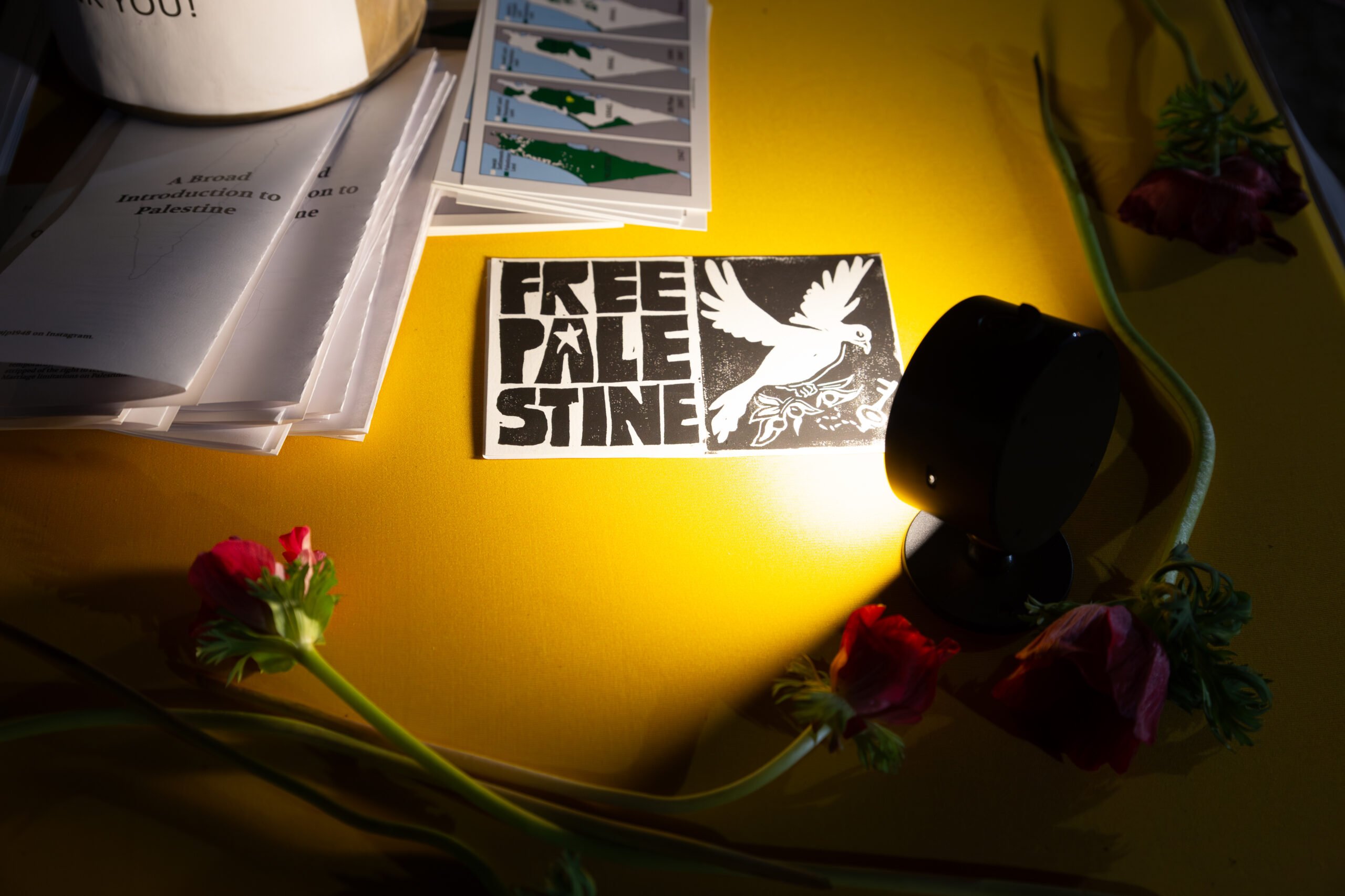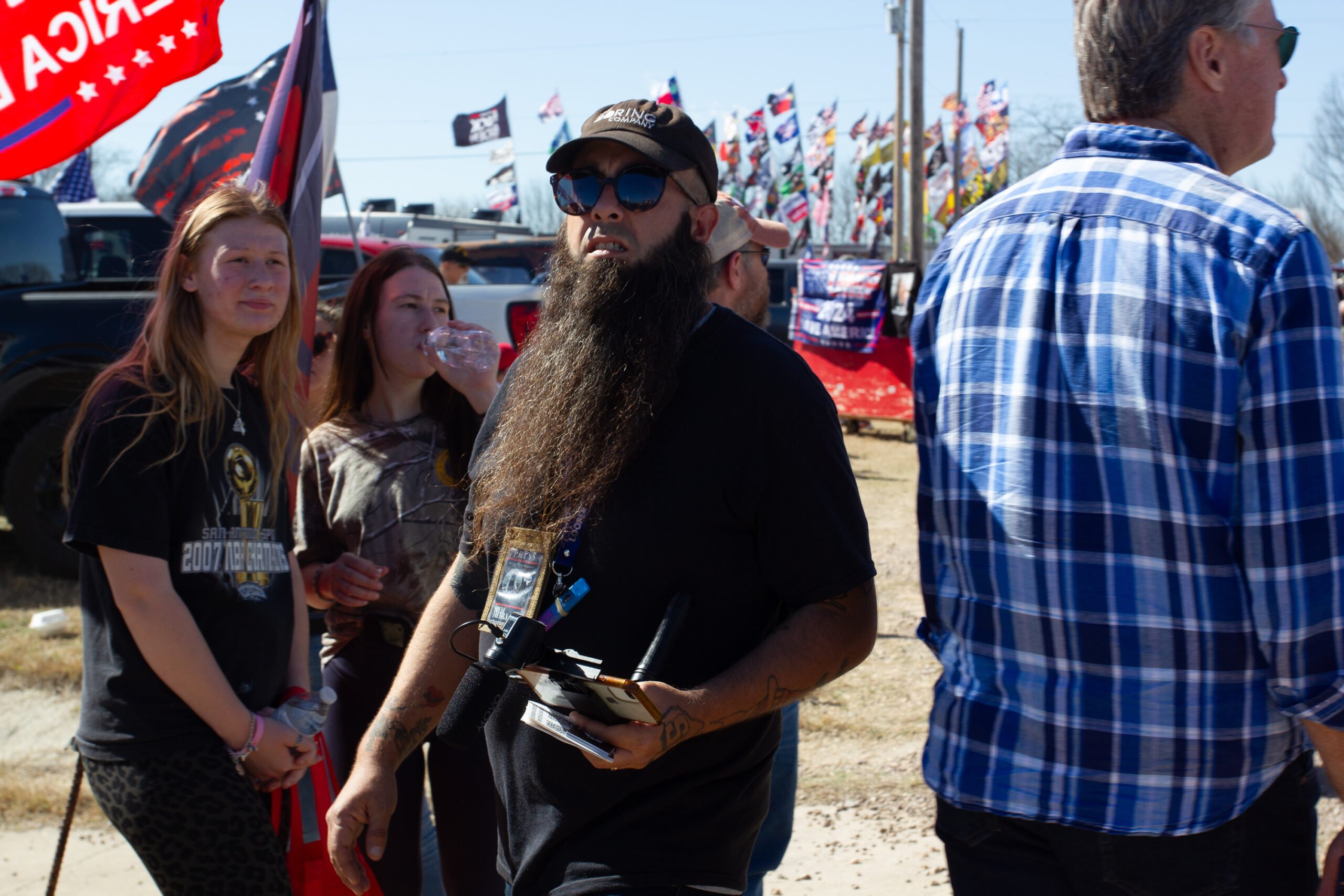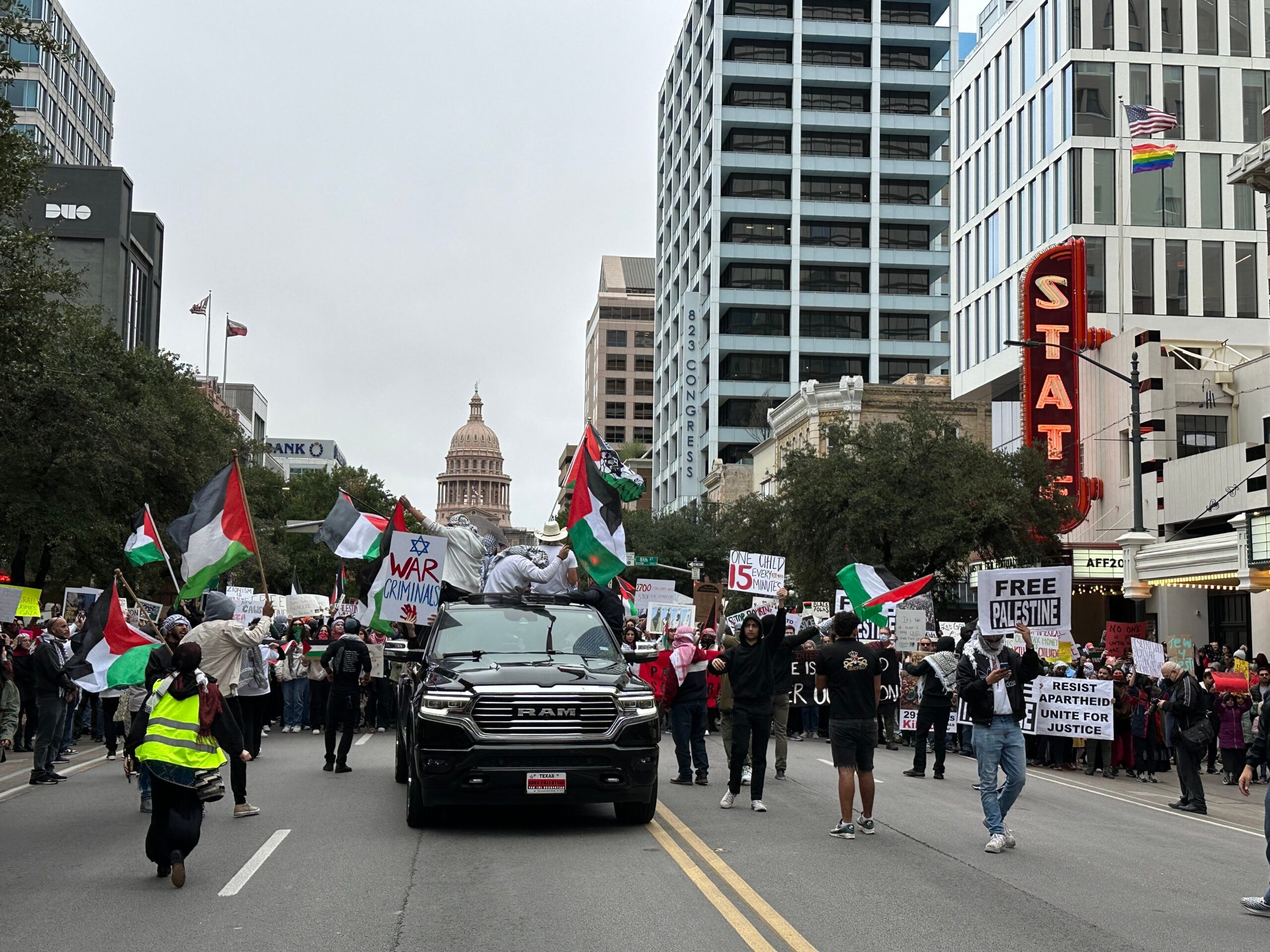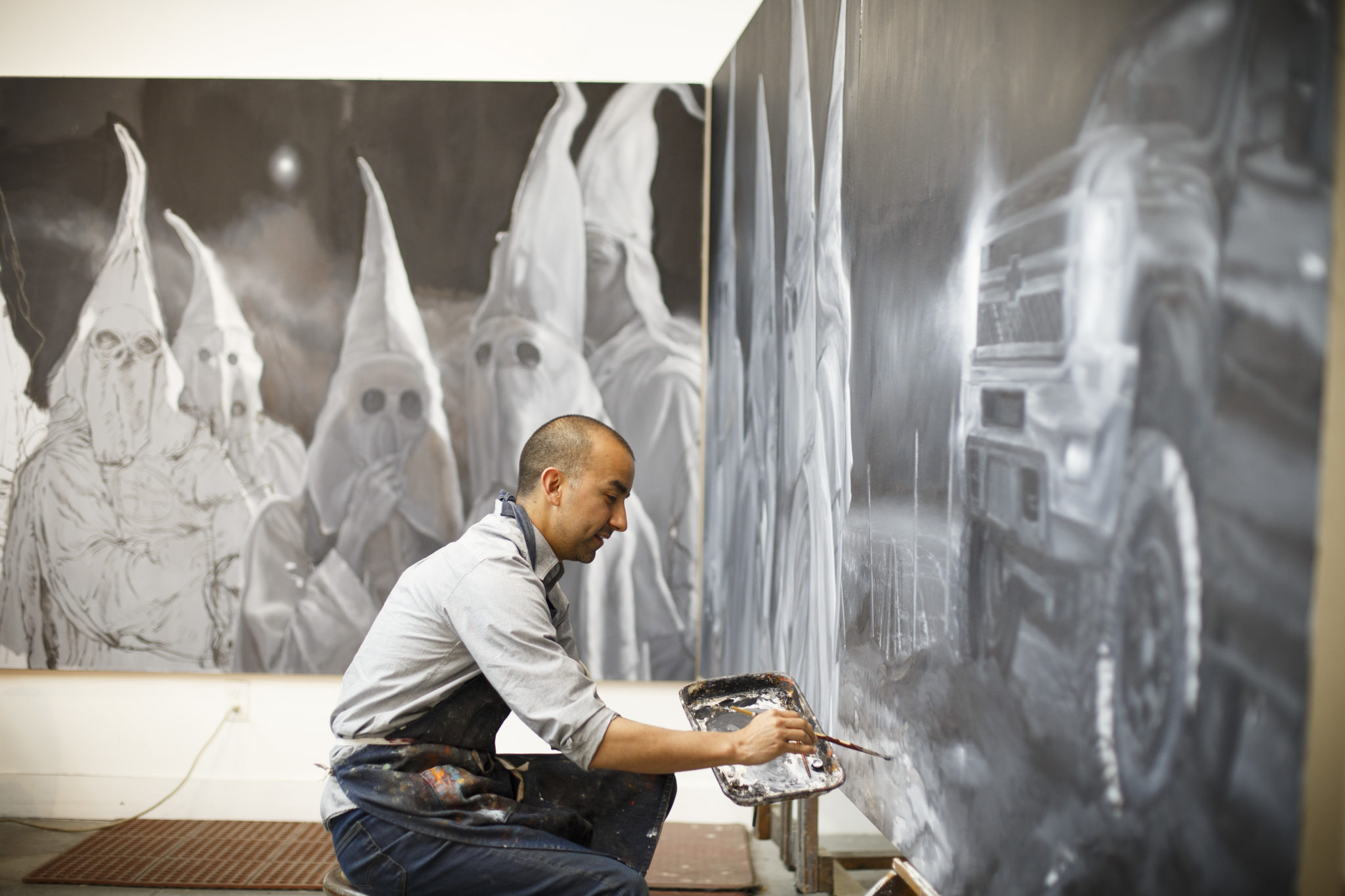
The Big Picture: Painting White Supremacy
San Antonio painter Vincent Valdez unveils a monumental work on the persistence of white supremacy in America.
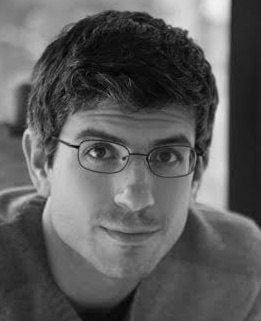
The Big Picture
San Antonio painter Vincent Valdez unveils a monumental work on the persistence of white supremacy in America.
A casual art viewer, wandering into the David Shelton Gallery in Houston from this month and encountering “The City,” Vincent Valdez’s new multipanel painting, could be forgiven for assuming that its subject matter was inspired by the rise of Donald Trump. Valdez’s work portrays a gathering of Ku Klux Klan members on the scrubby outskirts of a glowing metropolis. Several visual clues — a modern Chevrolet truck with rims, an iPhone, Nike sneakers — confirm that this is no tableau of the Jim Crow-era South but a portrait of a modern-day menace instead. By juxtaposing contemporary details with the costumes of the infamous knights of the pre-civil rights, segregationist social order, Valdez appears to be highlighting an ominous return of outspoken white supremacy, evident everywhere this summer, from crowd-sourced police brutality videos to an increasingly viral and virulent far-right Twitter echo chamber to the lips of a Republican presidential nominee who was endorsed by KKK grand wizard David Duke.
Valdez doesn’t mind that reading of his painting, but, he says, it’s only part of the picture. In fact, he first conceived of the painting seven years ago, near the start of the Obama administration, a time when the phrase “post-racial America” was still sometimes used without irony in the press. San Antonio-raised Valdez was living in Los Angeles at the time. Discussing his sojourn there, Valdez hints at the initial inspiration for “The City,” which features a landscape reminiscent of Southern California. “I love LA,” Valdez says with a mix of sincerity and irony. “It’s extremely dynamic — earthquakes, traffic. The LAPD.”
For a long time, the idea for a painting of hooded KKK figures in a modern setting remained germinal. It took years to fully develop. “I’ve become more and more comfortable as an artist with the fact that I get these ideas and filter them out over years, store them away in my head,” Valdez explains. “The ones really worth executing make it to the drawing board or easel.”
Moving back to Texas helped. “I came home in 2010 to regather myself,” Valdez says. “The noise of a city like LA takes a toll in terms of focus. That’s something I was really able to do easily here — lock the studio door and just work.” Over the course of six years, Valdez has developed from a promising young emerging artist to one of the most recognizable painters in the state, with a Texas Commission on the Arts State Artist award in 2015, a solo exhibition scheduled for 2017 at the National Portrait Gallery in Washington, D.C., and coverage of his work as far afield as the New York Times.
Throughout this period of accelerated creative output, the KKK subject matter was turning over in the back of Valdez’s mind. His conceptual breakthrough came last October, when he traveled to Austin to view Witness, an exhibit on art of the civil rights era, at the Blanton Museum. Valdez describes turning a corner in the museum and being confronted with a canvas by Philip Guston, a prominent American abstract expressionist who, in the social ferment of the late 1960s, suddenly turned to figurative painting with a shocking series of canvases depicting KKK figures. Guston’s “City Limits” (1969) depicts a trio of white knights crammed into a big-wheeled car, simultaneously suggesting a military or police vehicle and something out of a Mickey Mouse cartoon. The hooded trio patrols a crimson-red urban landscape, presumably keeping the undesirables out.
“In the studio, I’m not sitting looking at the wall thinking, ‘How can I change people?’” Valdez says. “These images are a response, reaction on my individual terms to the world I’m part of.”
Valdez returned to his studio in San Antonio, ran to his flat file, and pulled out drawing paper. By midnight, he says, he’d filled four sheets of paper with a series of related small drawings. “Two Klan members turned into six, then a vehicle. I got so excited about the thing, I decided, ‘I have to paint this.’ I stretched the canvases; I was ready to get brushes. Then I decided, ‘No, this thing has got to be monumental.’”
***
Valdez is no stranger to working in large formats and with politically controversial subject matter. He has been doing it since he was 10 years old. In fifth grade, his South Side school was invited to participate in an outdoor mural project led by a young painter named Alex Rubio, who has since become another well-known San Antonio artist. Valdez showed up with a notebook full of drawings. Rubio flipped through it and, impressed, offered Valdez his own section of wall.
To describe young Valdez’s work as precocious would be an understatement. “Everyone to the left and right of me were doing rainbows and stick figures,” Valdez recalls. “My section had nature, animals, people harvesting their fields, and in the background, fighter planes coming in to drop napalm.” Ten-year-old Valdez added the text “Make food not war” his first public indictment of U.S. foreign policy.
Valdez found a mentor in Rubio, then 19, who had grown up in a West Side San Antonio housing project and built a burgeoning career as a muralist. Rubio met with Valdez’s mother and convinced her that her son was born to be an artist. She may not have needed much convincing. Valdez’s paternal grandfather, Jose Maria Valdez, had been painter as well. Valdez never met his grandfather, who had emigrated from Spain to Mexico and on to San Antonio. But he remembers poking around old canvases painted by his late relative depicting social struggles of post-revolutionary Mexico. One, which Valdez now owns, features the French figure of Marianne (inspiration for the Statue of Liberty) draped in a Mexican flag, surrounded by figures representing Mexican workers and social movements.
“It was my first museum,” Valdez says of his grandmother’s house.
For several years, Valdez went to work with Rubio every summer painting outdoor murals.
“It literally was my initiation,” Valdez says. “It taught me to think critically and that I could be an activator, helping others to think critically. There was something about sitting on those walls, having people drive up to see what we were doing, this unity with the community and people. It was for people, about people, and by people from the community. That’s something that I’ve never completely abandoned.”
Valdez also got his first taste of public acclaim through his mural work. In 1989, at a time when people with HIV and AIDS were still heavily stigmatized in mainstream American society, Valdez contributed to an AIDS awareness mural that the city chose to put on the cover of textbooks given to children throughout the public school district. At 12 years old, he was already reaching a broad audience of his peers.
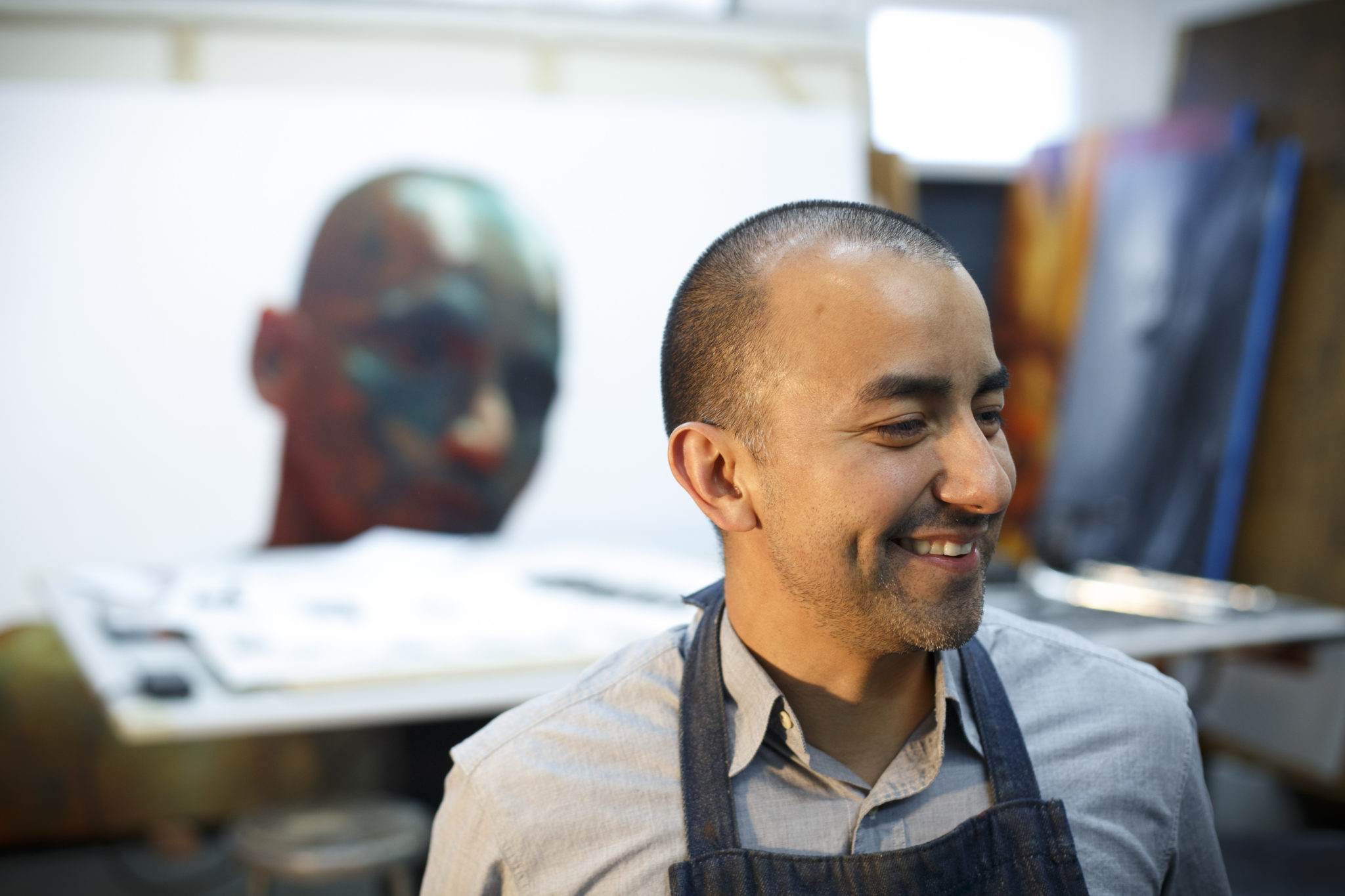
Since the turn of the millennium, street art has entered a period of unprecedented respectability in U.S. museums and art sales, but Valdez has tacked in the opposite direction. The early story of his adult artistic development hinges on his attempts to bring the critical and participatory idealism of his early mural work into a studio art practice. “Murals are never permanent,” he explains. “That’s one reason I decided to go into the studio. I was thinking about the life of the piece.”
He has also strived, as a mature artist, to temper the stridency of his youthful political polemic. In place of cut-and-dry slogans like “Make food not war,” Valdez now aims to foster a space for open-ended reflection on social problems. “In the studio, I’m not sitting looking at the wall thinking, ‘How can I change people?’” Valdez says. “These images are a response, reaction on my individual terms to the world I’m part of.”
“There’s always a bigger picture,” he adds. “Something larger than life, not only in scale and way they’re composed, the visual language, but there are very complex layers that have to be peeled apart. That becomes the socially active part. Engage the viewers, so for 13 seconds they stand in front of a painting and maybe it sparks one or two lightbulbs for them like it does for me in the studio.”
Valdez found early art-world success when his 2001 canvas “Kill the Pachuco Bastard!” was featured in Chicano Visions, a traveling exhibition drawn from the collection of comedian Cheech Marin. In 2004, at age 26, Valdez became the youngest artist ever to receive a solo exhibition at the McNay Art Museum in San Antonio, for “Stations,” a narrative series of canvases chronicling a boxing match with heavy religious undertones. But Valdez’s most lauded body of work — at least up until this month’s unveiling of “The City” on display from September 9 through October 8 at Houston’s David Shelton Gallery — is probably his 2013 series “The Strangest Fruit.”
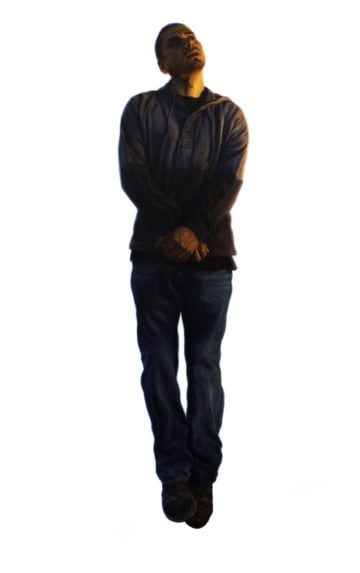
These large, full-body paintings of Hispanic men in contemporary dress tend to strike viewers as unusual in both pose and mood, but it can be hard to determine just what Valdez is up to without turning to supplementary texts. The painting subjects don’t seem to be resting their weight on their feet, but their bodies are responsive to a peculiarly distributed gravitational force. David Shelton, Valdez’s Houston-based gallerist, told me that many first-time viewers assume these are portraits of young men ascending to heaven.
In fact, the canvases in the “The Strangest Fruit” series are inspired by historical lynchings of Mexican Americans in the United States. Valdez chose to recreate old photographs or re-imagine historical descriptions of lynchings using subjects in modern-day street wear. They posed with ropes around their necks, but Valdez removed the ropes from his paintings, leaving his contemporary subjects in uncanny states of suspension against blank white backgrounds.
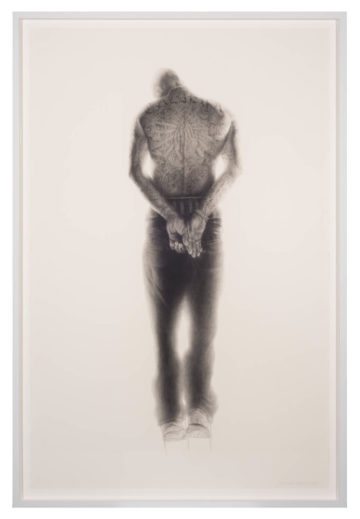
Scholars William D. Carrigan and Clive Webb, authors of Forgotten Dead: Mob Violence against Mexicans in the United States 1848-1928, have identified at least 547 Mexican and Mexican-American victims of mob justice during the time period referenced in their title, though they suggest the numbers of unknown dead is likely much higher. “In contrast to the African Americans murdered by lynch mobs … the photographic record of Mexicans extralegally executed is slight,” Carrigan and Webb note in an essay for the “The Strangest Fruit” catalogue, produced by Staniar Gallery at Washington and Lee University. “The reason for this is that, in contrast to the many African Americans who were murdered in ritualized acts of communal violence, Mexicans targeted by lynch mobs mostly met their deaths in remote areas far from public view and far from the nation’s premier media sources.”
As such, “The Strangest Fruit” amounts to a public education project about a little-known episode of American history. It’s easy for many Americans to intuitively draw connections between the well-known history of black lynchings in the Jim Crow South and, say, recent highly publicized videos of police executions of innocent and unarmed black people. Without knowledge of the 19th and 20th century waves of xenophobia and mob violence against Hispanics, however, it’s perhaps more difficult for ordinary Americans to detect the implicit threat of deadly violence in today’s Trumpian slogans and racial insults.
Valdez uses the perverse beauty of his subjects’ strained poses as an engine to foster historical curiosity, much like the way the gorgeously sinister Billie Holiday tune referenced in his series’ title used melody to draw listeners towards activism. For his exhibition, Valdez even rewrote a few of the famous lyrics to “Strange Fruit,” originally composed by Abel Meeropol. Valdez replaced “magnolia trees” with “pecan trees,” for example, and substituted “pastoral scene” with the historically charged “forgotten scene”:
Texas trees bear a strange fruit
Blood on the leaves and blood at the root
Brown bodies swingin’ in the Southern breeze
Strange fruit hangin’ from the pecan treesForgotten scene of the gallant South
The bulgin’ eyes and the twisted mouth
Scent of desert rose sweet and fresh
Then the sudden smell of burnin’ flesh…
For all the bleakness of his subject matter, Valdez speaks with great optimism of taking “The Strangest Fruit” to various institutions around the country. Especially at Brown University’s David Winton Bell Gallery, he says, his conversations with artists and scholars convinced him that Texas artists, Hispanic artists in particular, are poised to gain greater recognition in the national art world. “Texas and the border have seemed so far removed from the rest of the national psyche, so it becomes this sort of new, untapped narrative,” he explains. “As we see the rise of the presence of Latinos in the U.S., this becomes a relevant topic. There seems to be something really brewing here in terms of being on the national radar. It’s past due.”

For a long time, Valdez was unsure how to follow up his success with “The Strangest Fruit.” In fact, as Shelton tells it, Valdez was even preparing a different set of paintings for his September show when he mentioned to his gallerist that he’d been working on something else. Would he like to see it? Shelton said yes.
“So he showed me the drawing — he’d just drawn it out a little bit,” Shelton says. “And I just said, ‘Yeah, you have to do that.’ But I could also tell that’s what he really wanted to do.”
Shelton is candid about the fact that art that engages controversial subject matter can be a hard sell on the open market. “Sometimes people do say, ‘I love this painting but I can’t have that in my house,’” he says. “Which, frankly, I can’t understand, but that’s me. But here there is the overriding factor of the level of skill involved. That interestingly overrides content sometimes, for some people.”
And though a painting featuring KKK hoods is a non-starter for a certain percentage of the collecting public, Shelton adds, “People who are attuned to it are very into it. And, obviously, museums like it as well.”
Valdez, for his part, does his best to ignore the question of marketability. “This was the one piece that I was pretty sure would never have a permanent home,” he admits. “I wasn’t sure who, be it institution or private collector, would want to get near the thing. I’m pretty good at turning that switch off while I’m making the thing. I’ve been lucky that my more challenging work has done well.”
As he developed his vision for “The City,” Valdez says, he sought specifically to move beyond the shock factor of his subject matter and engage with deeper questions and layers of meaning — the “bigger picture” he always aims to touch through surface-level pictorial strategy. “I was least interested in promoting another menacing violent image of these men in hoods,” Valdez says. “We’ve seen that; we understand it. My challenge was depicting these individuals as individuals. They are Americans. They are human beings. They’re not larger than life in the sense that under those hoods, there’s some non-human quality to them. I wasn’t viewing them sympathetically, but I was trying to place them at the viewer’s level, or my level.”
Initially, Valdez borrowed inspiration from music, specifically the song “The Klan” by R&B/hip-hop pioneer Gil Scott-Heron. Valdez speaks of intending his painting as the final piece of an imagined Klan-themed triptych by three American artists, brown, black and white — himself, Scott-Heron and Guston. He even planned to title the work “For Guston and Gil Scott.” However, Valdez says, as the work grew in scale, he made the important decision to break away from the strictures of homage. “I became the passenger,” he says. “The painting was going where it wanted.”
Instead of illustrating archetypal villains, Valdez says, he conceived of the painting as a personal encounter with a specific set of strangers. “If I was bumming around one night in a city, a place I didn’t know well, and I walked right into the center of this circle where they’re about to have a meeting, what would it be like?” he asks.
His curiosity led him to interrogate the term “clan.” He drew on warm feelings about barbecues with his own family, as well as more romantic visions such as American beer commercials, to arrive at a portrait of a family that includes a variety of characters, each with their own preoccupations. Viewers will note small groups conversing or focused on preparing the pyrotechnics, teenagers eager to break away from the group, and a mother and baby in adorable little Nikes. “It helped me to kind of dissect and evaluate the feeling of necessity of a group like this,” Valdez says. “When you feel like your family unit is under threat, there’s a sense of anger, hostility, fear.”
“My challenge was depicting these individuals as individuals. They are Americans. They are human beings. They’re not larger than life in the sense that under those hoods, there’s some non-human quality to them.”
“That’s beyond my control — I’m not opposed to it,” Valdez says of the tendency among viewers of his new painting, including the New York Times, to make the connection to current events. He insists, however, that the contents of “The City” have been percolating in his mind for years. “That should be testament that this has never gone away,” he adds. “It’s more present than ever in our modern, so-called progressive world.”
Valdez invokes the words of Gore Vidal: “We are the United States of Amnesia. We learn nothing because we remember nothing.”
If there’s a single through-line to Valdez’s career so far, perhaps it’s a stubborn, hopeful refusal to accept the fatality of Vidal’s diagnosis — a furious insistence on remembering our history, dragging old skeletons out of the closet and examining them in all their ghoulish beauty.
“How have things really changed and how have they not, I think, is the ultimate question,” Valdez says of his newest work. He mentions that the finishing touch, which he had not yet completed at the time of our interview, would be a small panel featuring the underbelly of a commercial airliner arriving in the city. “There’s a shift happening. Two worlds are being pulled apart, or pulled together. You, as a viewer, are stuck in between. You have to decide who you are, where you are, and how you got there.”
